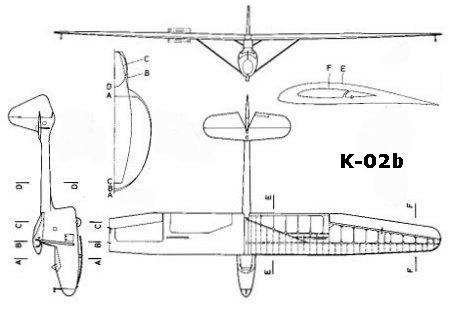HUNGARIAN
GLIDERS
1933-2000
| Type designation: |
K-02, K-02b |
| Name: |
Szellő |
| Designer: |
Sándor KEMÉNY |
| Class: |
Training |
| General arrangement: |
High strutted wing, pod-and-boom fuselage, traditional tail unit |
| Crew: |
1 |
| First flight: |
September 10, 1949 |
| Manufacturer: |
MÁV Istvántelki Főműhely, Sportárutermelő V. (former Aero Ever Ltd.), Esztergom |
| Number of built: |
90 |

Short history:
In 1948 the Hungarian National Flying Association (OMRE) invited tenders for a primary glider design. The aim of the tender had been to find a construction designed of domestic materials and for serial production. The glider designated K-01 and designed by Sándor Kemény won second prize behind Ernő Rubik's R-16 Lepke. In 1949 an opportunity opened up to build the runner-up design as well. As the serial production of R-16 Lepke had been already decided, the design of the Szellő was modified by its designer. The new version, K-02 Szellő, was aimed to be capable of ridge soaring even in light winds. The glider was designed by OMRE's design bureau with György Mező as co-designer.
The prototype was built at MÁV Istvántelki Főműhely (Istvántelki Workshop of the Hungarian Railways), and first flew at September 10, 1949. The K-02 had very good flight handling characteristics. It was decided to develop it further to get a good training glider type.
The development work was done mostly by György Mező, Gábor Jereb and József Zappel. Among the applied refinements the barcing cables were omitted, an airbrake of Rubik type and a fixed wheel behind the c.g. were fitted. The new version got the designation of K-02b. The prototype of this version first flew at August 20, 1950. The drawings for the serial production were prepared jointly by the design bureau of the Hungarian Aeronautical Association and design section of the Sportárutermelő Vállalat, Esztergom. Altogether 89 serial examples were built by the Sportárutermelő Vállalat. The type was used by student pilots up to the middle of 60s to gain the siver badge.
The K-02b was licenced to be launched by bungee-cord, winch and aerotowing.
Structure: All wooden
Wing:
The glider was high-wing "pod-and-boom" design. The center part of the wing had a rectangular palnform and the outer panels petered off to rounded wingtips. The strutted wing had one main spar and a diagonal secondary spar at the inner part as well as a parallel one at the 70% of the chord.. The wing was covered by plywood in front of the main spar and by fabric behind it. On the K-02 there was no airbrake fitted due to the anticipated small landing speed. However the K-02b version had a Rubik type airbrake. The ailerons were of Frise type.
Fuselage:
The fore part of the fuselage had an elliptical cross section. The main structural element of this part of the fuselage was a strong keel, and was covered by plywood. Behind the cockpit the fuselage consisted of a quadrangular section box beam connected to the keel. On the K-02 prototype this boom was braced by steel cables to the main spar. The landing gear consisted of a two-part skid with rubber ring springs. On the K-02b version a fixed wheel behind the c.g. was fitted.
Tail unit:
The tail unit was tarditionally arranged and a strutted horizontal stablizer was fitted.
.jpg)

| Dimensions: |
| Wing: |
| Span, m: |
12,6 |
| Area, m2: |
14,8 |
| Aspect ratio: |
10,7 |
| Chord (root), m: |
1,35 |
| Chord (tip), m: |
0,75 |
| Airfoil (root), m: |
Gö 549 |
| Airfoil (mid-span), m: |
Gö 549 |
| Airfoil (tip), m: |
Gö 676 |
| Dihedral, degree: |
1,5 |
| Sweep, degree: |
0 |
| Washout: |
Aerodynamic and -4 degree geometric |
| Aileron: |
| Span, m: |
3,8 |
| Mean chord, m: |
0,32 |
| Total area, m2: |
2,3 |
| Balancing: |
Aerodynamic |
| Flap: |
| Type: |
None |
| Airbrakes: |
| Type: |
Rubik |
| Position (upside/downside): |
u/d |
| Total area, m2: |
0,42 |
| Position, % of chord: |
0,402 |
| Horizontal stabilizer: |
| Span, m: |
2,8 |
| Area, m2: |
2,11 |
| Elevator: |
| Span, m: |
2,8 |
| Area, m2: |
1,34 |
| Airfoil: |
-NACA 0009 |
| Balancing: |
None |
| Trim: |
Yes |
| Vertical stabilizer and rudder: |
| Total area, m2: |
1,21 |
| Rudder area, m2: |
0,81 |
| Balancing: |
None |
| Fuselage: |
| Length, m: |
6,5 |
| Width, m: |
0,62 |
| Height: |
1,18 |
| Cross section, m2: |
0,65 |
| Landing gear: |
| Type: |
Fixed |
| Wheel diameter, m: |
0,26 |
| Masses: |
| Wing, kg: |
72 |
| Fuselage, kg: |
40 |
| Tail unit, kg: |
9 |
| Empty glider, kg: |
130 |
| Gross, kg: |
210 |
| Ballast, kg: |
None |
| Wing loading, kg/m2: |
14,2 |
| Speeds: |
| VNE, km/h: |
140 |
| Max. speed with open airbrakes, km/h: |
140 |
| Max. aerotow speed, km/h: |
110 |
| Max. winch speed, km/h: |
75 |
| Max. speed in rough air, km/h: |
110 |
| Stall speed, km/h: |
48 |
| Performance: |
| Min. sink, m/s (at gliding speed, km/h): |
0,9/56 |
| Best L/D (at gliding speed, km/h): |
19/65 |
| Start methods: |
Bungee, Winch, Aerotow |

Origin of data and 3-view drawing:
Jereb Gábor: Magyar vitorlázó repülőgépek, Műszaki Könyvkiadó, 1988, Budapest
(Gábor JEREB: Hungarian Gliders, Technical Publishing House, 1988, Budapest)
Gábor FEKECS E-mail: fekecs.gabor@t-online.hu

.jpg)
